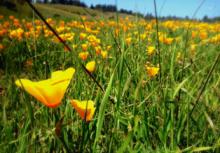
Photo courtesy of Molly Travis
To celebrate the natural beauty of our Santa Cruz lands and sea, we are going to begin featuring native-to-Santa Cruz County flora and fauna each week. For our first Native Plant of the Week, we are featuring the delicate golden beauty that bears the distinction of being our State Flower: the California Poppy (Escholtzia californica). We've probably all seen California poppies blooming in meadows like the UC Santa Cruz Great Meadow (where the image to the right was taken by UCSC student Molly Travis). Perhaps you've come across them on a hiking trail or have seen them growing along rural roads. Though we've all seen them, we came across some history and information to help us all appreciate these golden beauties even more.
What's in a Name?
In the 1800s, visitors to the California coast described the hills as "golden" because of the blanket of California poppies visible from the waters off the coast (1). One such visitor was Adelbert von Chamisso, a Russian naturalist on a ship that visited San Francisco in 1820 (2). He was the first visitor to the Americas to write about the California poppy, although it is likely that other visitors as early perhaps as the 1540s would have seen them blooming in the hills (2). Chamisso elected to name the genus after Johann Friedrich Eschscholtz, a friend of Chamisso and physician on the Russian ship that he traveled with (2).
Of course, the first people to name and know the California Poppy were the many tribes of people native to California. Since the California Poppy is found throughout the western and southwestern U.S., there are likely many indigenous names for the flower (3).
"Early Spanish explorers called the plant 'copa del ora,' which means 'cup of gold,' after the legend which said that the orange petals of the California filled the soil with gold" (3).
If you were to rename the California poppy, what name would you give it?
Indigenous Uses for the Poppy
"Traditionally Native Americans used the California poppy for both food and medicine. Some groups boiled or steamed the plants to be eaten as a green vegetable. Other indigenous peoples used the California poppy to treat various illnesses such as toothaches, headaches, sores, to kill lice and as a sedative for babies" (3). In The Wizard of Oz, Dorothy and friends fall asleep in a field of poppies, a reference to their real-life sedative properties that Native Americans knew and used as medicine.
State Flowerhood
"On December 12, 1890, the California State Floral Society voted to select a State Flower. The three nominees were Eschscholzia californica, the California poppy, Romneya coulteri, called giant poppy at the time, but now usually referred to as Matilija poppy, and Calochortus (no species indicated), the mariposa lily. The California poppy won by a landslide; only three votes were cast for Calochortus, and none for Romneya," writes Professor Emeritus of Biological Sciences at Cal Poly Pomona, Curtis Clark (2). If the vote had gone differently those many years ago, it wouldn't be illegal to pick California poppies and instead of learning about them in elementary school, children in California would have learned about an entirely different flower.
Given its appearance and what you now know about the California poppy, would you have chosen the California poppy as our state flower?
Bibliography & More Information
1. Burt, Jonathan. "The Biogeography of California Poppy." San Francisco State University. http://online.sfsu.edu/bholzman/courses/Fall02%20projects/calpoppy.html
2. Clark, Curtis. "The Genus Eschscholzia." Cal Poly Pomona. https://www.csupomona.edu/~jcclark/poppy/history.html
3. "California Poppy." Maunakea Visitor Information Station. http://www.ifa.hawaii.edu/info/vis/natural-history/flora/california-poppy.html